Chapter 20
From an-Nasiriyah to Tarawa
Living the Motto
By Jonathan Bernstein, Arms and Armor Curator
Featured artifacts: Relic, Helmet, M1 (2019.162.7); Relic, Canteen, M1942 (2019.162.11); and Relic, Cross, Cemetery (Name Post, Robert Hillard) (2019.162.23)
The U.S. Marine Corps motto Semper Fidelis (always faithful) has long been a touchstone to Marines both during and after their time in uniform. The concept of always being faithful to one’s country and comrades has gotten many Marines through some of the most difficult times they have ever faced. For some, the motto becomes part of their very being. Whether on the battlefield of an-Nasiriyah, Iraq, or facilitating the discovery and repatriation of long-missing U.S. servicemembers, retired Marine Corps sergeant major Justin D. LeHew has come to exemplify that motto.
LeHew enlisted in the Marine Corps in the summer of 1988 and upon graduation from boot camp was sent to Marine Corps Base Camp Pendleton, California, to attend the Assault Amphibian School. His first 18 months in the Corps were spent on deployments to Okinawa, South America, and Saudi Arabia during Operation Desert Shield (2 August 1990–17 January 1991), all as a member of the 2d Assault Amphibian Battalion.
The 2d Assault Amphibian Battalion provided the mobility for two of the 2d Marine Division’s infantry regiments and the division’s combat engineers. Lance Corporal LeHew crewed one of the battalion’s AAVP7A1 assault amphibious vehicles (AAV) as they rolled northward into Iraqi-occupied Kuwait at 0530 on 24 February 1991, the opening of the ground campaign in Operation Desert Storm (17 January–28 February 1991). The 1st and 2d Marine Division moved northward, breaching the defensive berm just north of the border and clearing paths through Iraqi minefields and obstacles as they went. At a press briefing on 27 February, as the ground campaign came to a close, the commander of U.S. Central Command, U.S. Army general H. Norman Schwarzkopf Jr., praised the Marine divisions for their race north: “I can’t say enough about the two Marine divisions. If I use words like “brilliant” it would be an underdescription of the absolutely superb job that they did in breaching the so-called impenetrable barrier. . . . It was a classic . . . absolutely superb operation, a textbook, and I think it will be studied for many, many years to come as the way to do it.”[1]
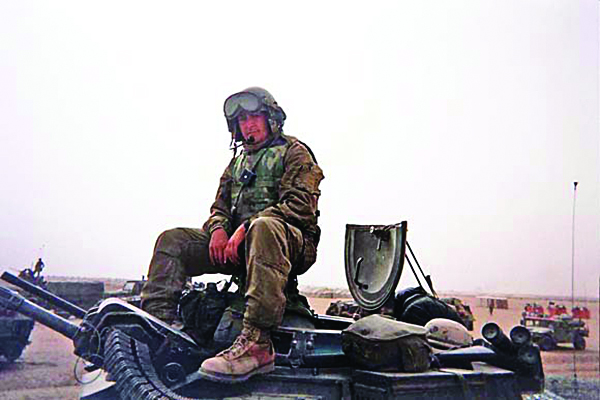
GySgt LeHew takes a break on top of his AAV, somewhere in Iraq, 2003.
Official U.S. Marine Corps photo.
During the next few years, LeHew excelled as an AAV commander and became an instructor at the Assault Amphibian School at Camp Pendleton, being named instructor of the year for two consecutive years. From there, he was selected for Drill Instructor School and served as a drill instructor, inspiring young Marine recruits to live the Marine Corps motto. As a result, Staff Sergeant LeHew was voted as the recipient of the Dan Daly Award twice by his fellow drill instructors as the best among them.
Lehew’s insight into what motivates Marines to keep their faith with each other is pervasive throughout his history. “Every Marine came into the Marine Corps to fight. They either have something to prove to themselves or someone else,” he said. “It’s the kids that can’t hold their personal life together that win battles. It’s the kid the platoon teases, or the kid that his buddies tease because he shoots marksman, that holds off half the Fedayeen. His biggest fear is not that he’ll fail, but that he’ll let his buddies down. What makes us elite is that we don’t want to let each other down.”[2]
By the beginning of the new millennium, Gunnery Sergeant LeHew was back with the 2d Assault Amphibian Battalion at Marine Corps Base Camp Lejeune, North Carolina, as a platoon sergeant. The next three years were a whirlwind of preparation for war following the 11 September 2001 terrorist attacks on the United States, with the battalion deploying to Saudi Arabia in early 2003. As the specter of war loomed large in early March of that year, the 2d Marine Expeditionary Brigade, known as Task Force (TF) Tarawa, would be among the first U.S. units to invade Iraq when the “go” order came. Company A, 2d Assault Amphibian Battalion, was attached to 1st Battalion, 2d Marine Regiment, for the operation and was tasked with transporting the battalion’s infantry to the fight. Crossing into Iraq on 21 March, TF Tarawa made rapid progress, securing Jalibah Airfield, roughly 50 kilometers south of an-Nasiriyah, by the following afternoon.
An-Nasiriyah was the first major Iraqi city encountered by the U.S. invasion forces, and TF Tarawa immediately ran into stiff resistance. Their objective was to secure the bridges across the Euphrates River and the Saddam Canal to the river’s northeast. As the task force moved out in the early morning, lead elements ran into a southbound damaged U.S. Army High Mobility Multipurpose Wheeled Vehicle (HMMWV, or Humvee) from the 507th Maintenance Company. An Army convoy had made a wrong turn and ended up deep behind enemy lines. By the time they realized their location and attempted to reverse course, they were in downtown an-Nasiriyah and getting shot to pieces in what became known as “ambush alley.”
During the next three hours, the Marines fought to reach and secure the survivors of the Army convoy and secure the an-Nasiriyah bridges. Company A reached the remnants of the 507th Maintenance Company, and Gunnery Sergeant LeHew led the rescue effort there, securing the wounded and beleaguered soldiers for movement southward. Company A secured the southern end of the Euphrates bridge, enabling Company C to continue the advance northward to capture the second bridge.
A severely damaged AAV from Company C came speeding southward from the northern bridge, reaching Company A’s positions and coming to a halt. The vehicle’s rear was almost completely destroyed, with the wreckage and debris burying the Marines inside. LeHew and his company corpsman, U.S. Navy hospitalman Alex Rodriguez, immediately jumped into action, dismounting their AAV and running under fire to get to the wounded Marines in the stricken vehicle.
Among those wounded on the AAV was Corporal Matthew Juska, who was in bad shape with a major head wound and possibly a broken back. LeHew remembers, “We had to get him out of there.” LeHew and Hospital Corpsman First Class Alex Velazquez worked tirelessly to recover all the Marines aboard the burning AAV. Most were dead, but their remains would be returned to their families. Juska ultimately survived and would see LeHew a year later at Camp Lejeune as he processed out of the Marine Corps.[3]
For his actions in rescuing both the survivors of the 507th Maintenance Company and the Marines aboard the AAV, LeHew received the Navy Cross. His citation reads:
For extraordinary heroism as Amphibious Assault Platoon Sergeant, Company A, Task Force Tarawa, I Marine Expeditionary Force in support of Operation IRAQI FREEDOM on 23 and 24 March 2003. As Regimental Combat Team 2 attacked north towards An Nasiriyah, Iraq, lead elements of the Battalion came under heavy enemy fire. When the beleaguered United States Army 507th Maintenance Company convoy was spotted in the distance, Gunnery Sergeant Lehew and his crew were dispatched to rescue the soldiers. Under constant enemy fire, he led the rescue team to the soldiers. With total disregard for his own welfare, he assisted the evacuation effort of four soldiers, two of whom were critically wounded. While still receiving enemy fire, he climbed back into his vehicle and immediately began suppressing enemy infantry. During the subsequent company attack on the eastern bridge over the Euphrates River, Gunnery Sergeant Lehew continuously exposed himself to withering enemy fire during the three-hour urban firefight. His courageous battlefield presence inspired his Marines to fight a determined foe and allowed him to position his platoon’s heavy machine guns to repel numerous waves of attackers. In the midst of the battle, an Amphibious Assault Vehicle was destroyed, killing or wounding all its occupants. Gunnery Sergeant Lehew immediately moved to recover the nine Marines. He again exposed himself to a barrage of fire as he worked for nearly an hour recovering casualties from the wreckage. By his outstanding display of decisive leadership, unlimited courage in the face of heavy enemy fire, and utmost devotion to duty, Gunnery Sergeant Lehew reflected great credit upon himself and upheld the highest traditions of the Marine Corps and the United States Naval Service.[4]
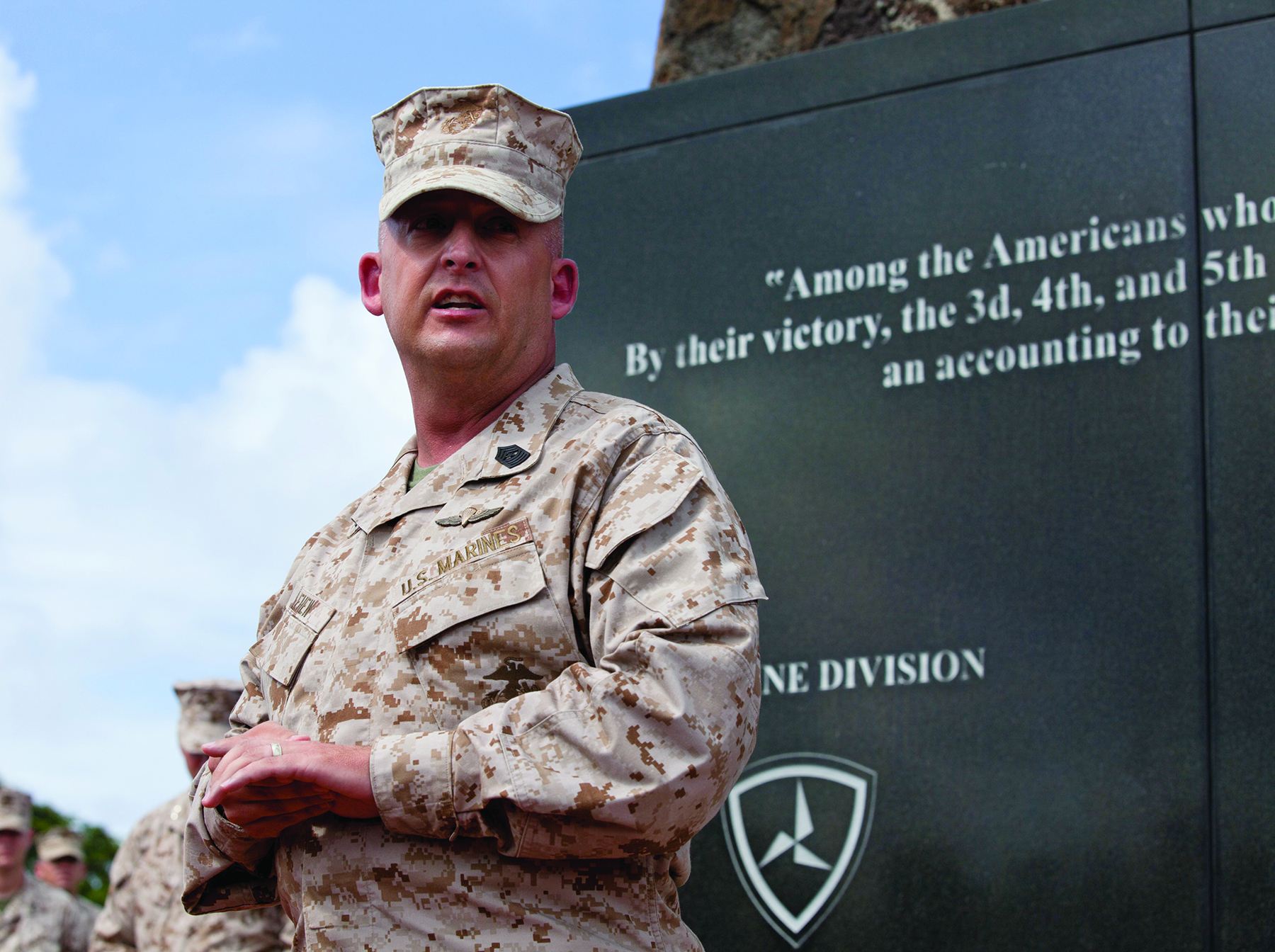
SgtMaj LeHew speaking in front of the Iwo Jima Memorial, ca. 2011.
Official U.S. Marine Corps photo.
LeHew later returned to Iraq for two additional combat tours, in 2005 as a company first sergeant with the 2d Assault Amphibian Battalion, during which he received a Bronze Star for valor, and in 2009 as the battalion sergeant major of the 1st Force Reconnaissance Battalion. He returned to the Assault Amphibian School at Camp Pendleton in 2010 as the schoolhouse sergeant major and then assumed responsibility as the regimental sergeant major for the 3d Marine Regiment. His final assignment in 2013 was at Marine Corps Base Quantico, Virginia, as the sergeant major of Marine Corps University.
Sergeant Major LeHew retired from the Marine Corps in July 2018 after 30 years of service. The next chapter of his life would see a continuation of his dedication to the ideals of the Marine Corps motto and establish him as a civilian leader in the challenge of bringing home U.S. servicemembers still missing in action. The promise of never leaving a fallen comrade behind is the central purpose of History Flight, a nonprofit organization specializing in research, recovery, and repatriation of missing servicemembers. Keeping true to the faith of those servicemembers—that they would be brought home—is at the heart of the Marine Corps’ motto.
History Flight was originally incorporated in 2003 as a 501(c)(3) organization dedicated to the preservation of U.S. military aviation history. The organization focused on World War II veterans and their families and providing rides in World War II-era airplanes to the public. However, there was a deeper intent to the organization’s activities. The funds from rides sold in their North American B-25H Mitchell, Boeing PT-17 Stearmen, and North American T-6 Texan airplanes were used to support efforts to locate and recover missing servicemembers from World War II battlefields. As the number of World War II veterans has waned, the organization has shifted its focus almost completely to those servicemembers still missing in action. The organization’s founder, Mark Noah, spearheaded the effort to locate and repatriate the more than 78,000 World War II servicemembers still missing in action and has since grown History Flight into the premier organization working with the Defense POW/MIA Accounting Agency (DPAA) to identify, recover, and reunite the remains of Americans lost overseas with their loved ones.[5]
The year 2008 saw the beginning of History Flight’s largest project, which continues today: the location of remains of U.S. Marines killed on Betio Island, Tarawa Atoll, during the Gilbert Islands campaign in November 1943. History Flight’s first visit to Tarawa resulted in the recovery of three Marines whose bones were openly displayed by the island’s natives. The recovery and subsequent identification of those three Marines led to additional interest and funding to continue the search.
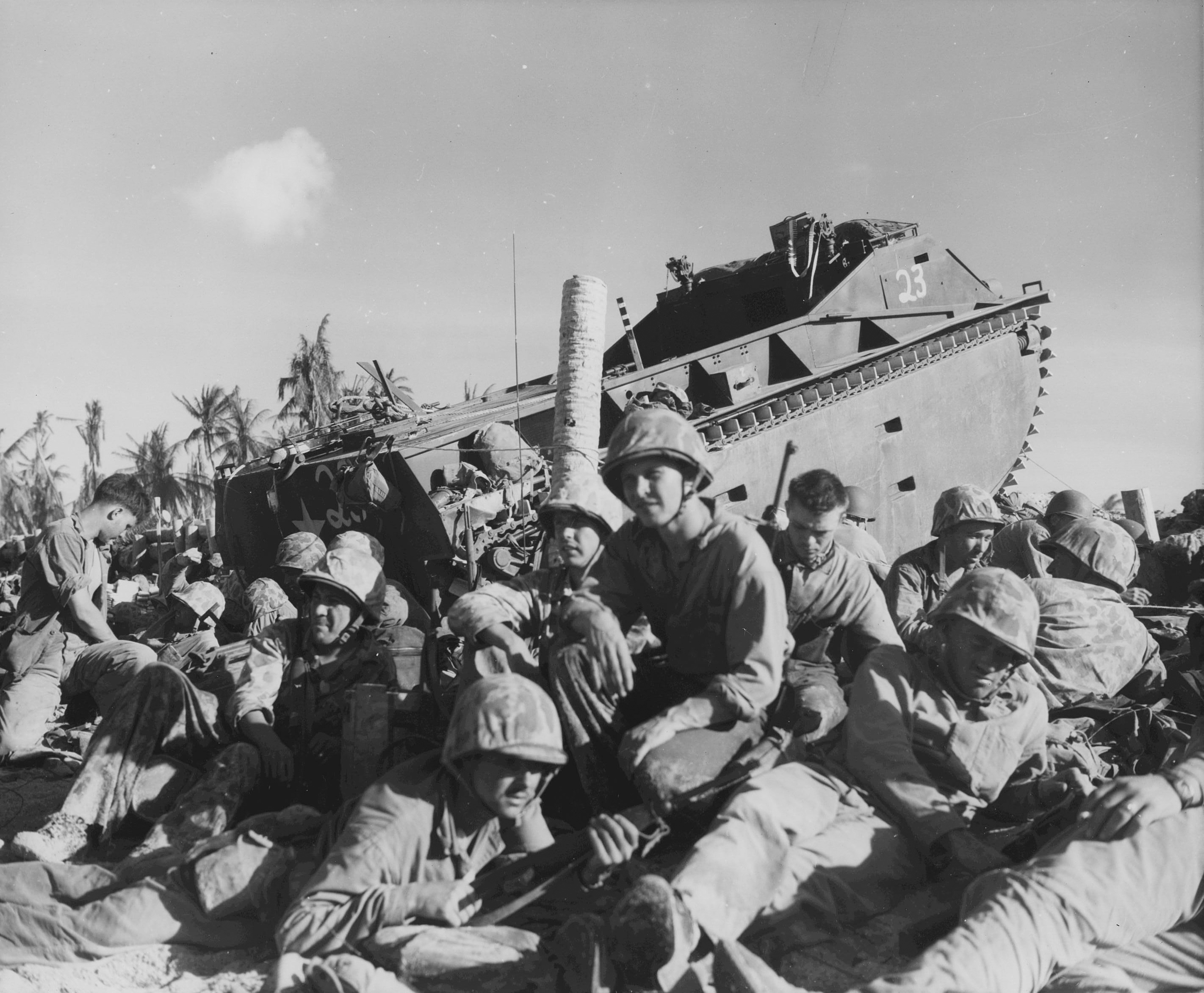
Marines on Tarawa take refuge behind an LVT-1 of the 2d Amphibian Tractor Battalion.
Marine Corps History Division.
With more than 400 U.S. Marines, sailors, and airmen still unaccounted for on Tarawa, the task was a daunting one. Part of the problem was the speed with which Tarawa was developed into a logistics hub after the battle. Runway expansion and construction of new buildings on Betio rapidly used up a great deal of space, including that of some smaller cemeteries that were hastily dug in the battle’s immediate aftermath. As the spearheading unit attempting to account for those buried on Tarawa, the U.S. Army’s 604th Graves Registration Company covered many of the Pacific battlefields beginning in 1944. Their efforts on Tarawa in 1946 enabled a significant amount of the hastily buried dead to be exhumed and consolidated into one cemetery, but many were still left unaccounted for. By the 1950s, the new U.S. Department of Defense was reluctant to continue expending funds on these efforts in an increasingly strained fiscal environment and therefore was willing to write off the remaining 78,000 missing in action servicemembers from World War II.
History Flight’s initial successes enabled it to develop a long-term strategy for the Tarawa missing, which began a 15-year, ongoing project to bring them home. The three Marines found on Tarawa were positively identified in 2014. Since then, History Flight’s research, coordination with the local populace, and professional excavation have unearthed a significant number of additional remains buried with equipment and uniforms, the largest of which occurred in 2015–16, when the remains of 51 servicemembers were located in what had been Cemetery 27. This area had not been identified in 1946 and had been untouched until History Flight’s discovery.[6]
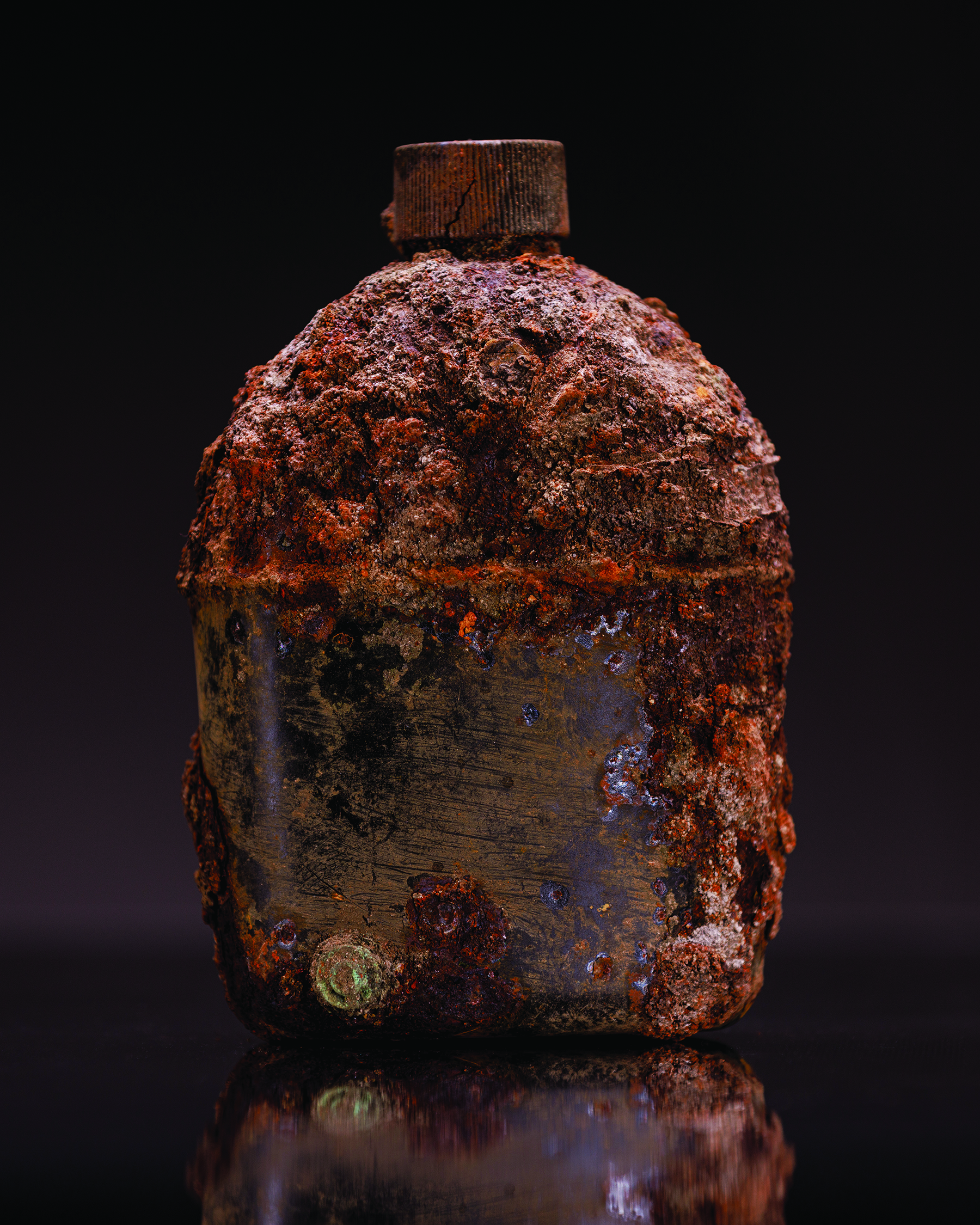
When this coral-encrusted black enamel canteen was recovered from a gravesite on Tarawa, it was still half full of water. The enamel finish is still visible on the lower portions of the canteen.
Photo by Jose Esquilin, Marine Corps University Press.
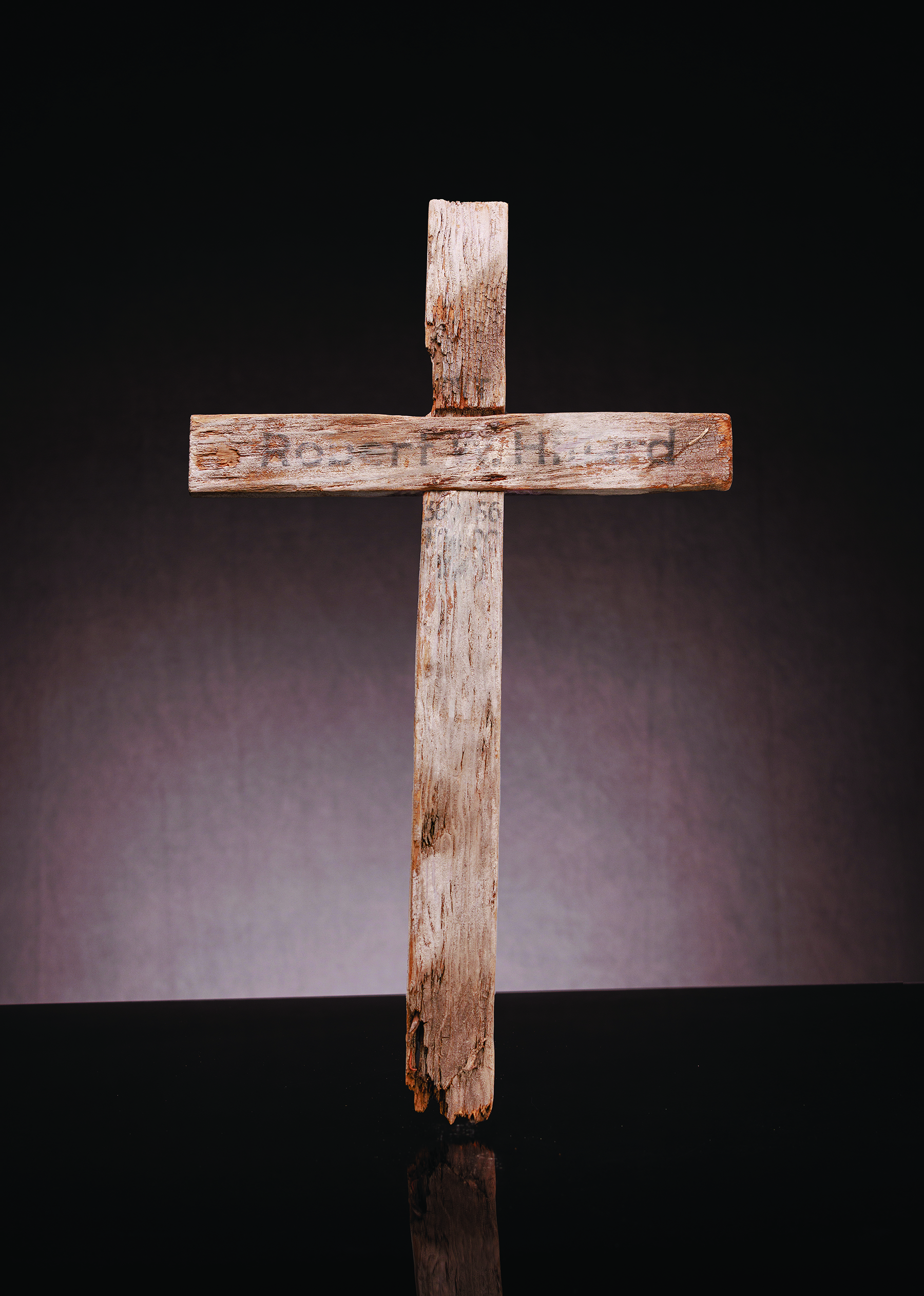
A temporary grave marker that identified the grave of Pvt Robert W. Hilliard from 2d Battalion, 2d Marines, who was killed in action on 20 November 1943.
Photo by Jose Esquilin, Marine Corps University Press.
In 2019, after Justin LeHew came aboard as the organization’s chief operating officer, History Flight donated several artifacts discovered on Tarawa during its excavations. Because these artifacts were not associated with any specific sets of Marine remains but were relics discovered on the battlefield, LeHew worked with DPAA to have them preserved with the intent of donating them to the National Museum of the Marine Corps (NMMC). “It was all pretty much relic status,” he said. “But for the trained eye . . . it was the entire battle history of the U.S. Marine Corps of that time period. . . . I knew I had to do something to preserve this.”[7]
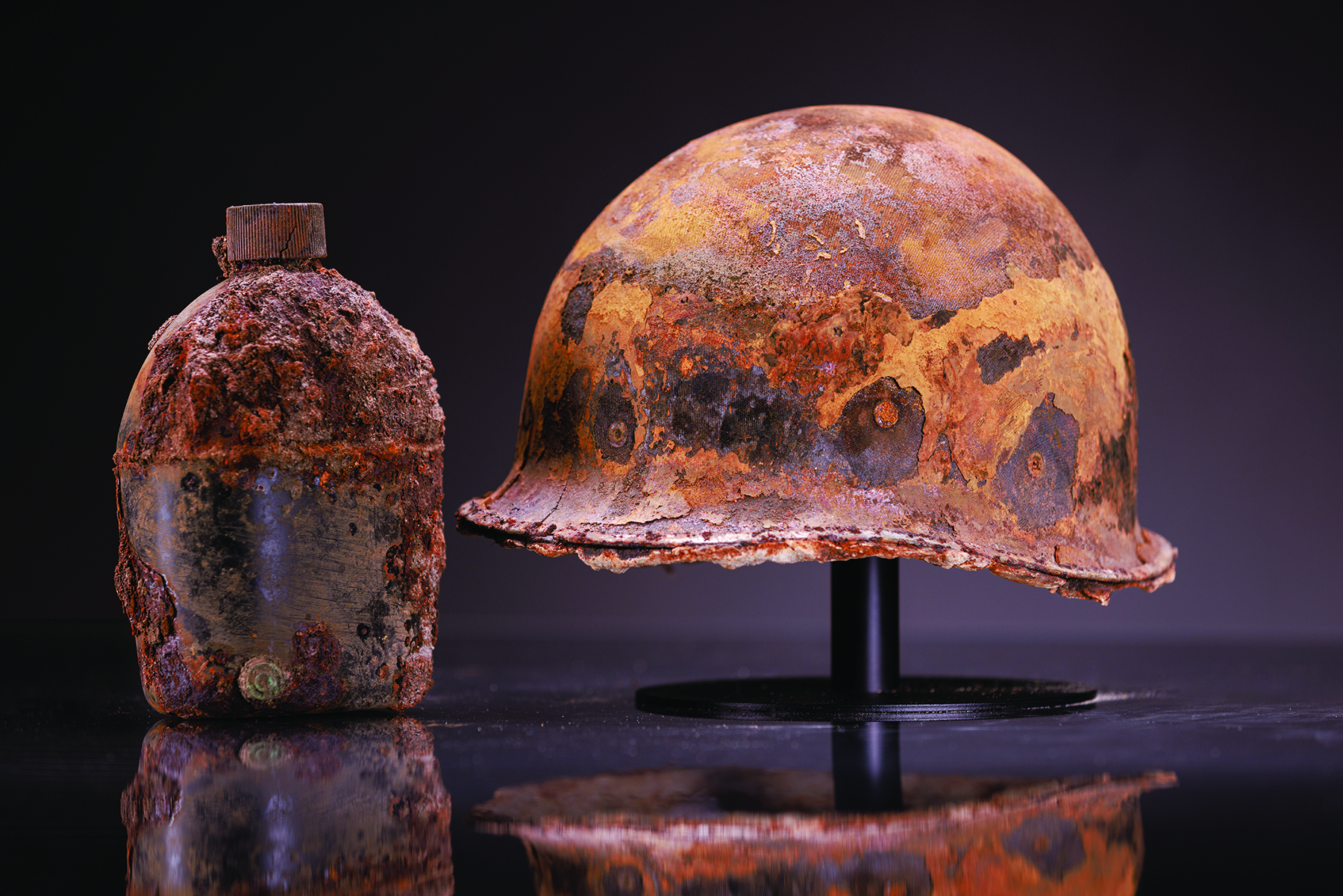
A Marine’s helmet that was recovered along with the canteen and grave marker. The helmet, while in relic condition, still has remnants of the cloth camouflage cover adhering to it.
Photo by Jose Esquilin, Marine Corps University Press.
One of the more fascinating artifacts found during the excavations is an M1942 enamel canteen. With aluminum supplies going primarily to aircraft production during the war, canteen production shifted to more readily available materials. The first steel canteens were ordered and only produced in 1942. These were dipped in either blue or black enamel to coat their surfaces and prevent rust. While effective, the enamel paint tended to fragment when hit, potentially causing additional fragmentation injury. Because of this, the Army chose not to use this type of canteen and passed most of the production run to the Navy and Marine Corps. The Tarawa canteen, a black enamel example, was produced by the Republic Stamping and Enameling Company. Although it is encrusted with coral sand, it still retains a good amount of its enamel finish, and when found, it still held half a canteen of water.
Along with this canteen, History Flight donated several pieces to the NMMC that would have belonged to Marines on Tarawa. After Marines fell in battle, they were often covered with or carried on their camouflaged ponchos to a casualty collection point. The remnants of a poncho, brittle and tattered but intact, were among the items discovered, along with pocket change, field dressings, and assorted other items.
The most striking artifacts are the remnants of three hastily constructed crosses bearing the names of three Marines that fell on Tarawa. All three crosses tell different stories of Marines who were killed on Tarawa in three days of intense fighting. Sergeant Bernard A. Marble was in Company L, 3d Battalion, 8th Marines, and landed on Red Beach 3 on D-Day (20 November 1943). He was killed on the second day of the battle as his battalion pushed south from Red Beach 3 and onto Tarawa’s main airfield.
Private First Class Clarence S. Hodgson was a mortarman in Company H, 2d Battalion, 8th Marines. Hit in both legs on the second day of the battle, he was evacuated to a hospital ship offshore, where medical personnel worked desperately to save his life. He succumbed to his wounds on 22 November and was buried at sea. The cross was erected in his memory at one of the makeshift cemeteries on Tarawa.[8]
Private Robert W. Hillard was one of 61 Marines from Headquarters Company, 2d Battalion, 2d Marines, killed on 20 November. The company’s landing craft reached shore and dropped their ramps right in the face of several Japanese machine guns, cutting the Marines to pieces as they attempted to come ashore.
While History Flight’s largest focus has been on Tarawa, the organization has also been instrumental in recovering and identifying the remains of more than 160 U.S. servicemembers in 15 different countries. To date, nearly 400 additional sets of remains located by History Flight have yet to be identified and are undergoing testing.
The stories that these artifacts enable the NMMC to convey are the final pieces in keeping with the motto Semper Fidelis. These objects allow museum curators to speak about those Marines lost on Tarawa and keep their memory alive, while simultaneously honoring a member of TF Tarawa and the “Hero of an-Nasiriyah,” who continues to keep true to the motto by remaining always faithful to his Marines.
Endnotes
[1] LtCol Dennis P. Mroczkowski, USMCR, U.S. Marines in the Persian Gulf, 1990–1991: With the 2d Marine Division in Desert Shield and Desert Storm (Washington, DC: History and Museums Division, Headquarters Marine Corps, 1993), 39.
[2] Cpl Matthew S. Richards, “U.S. Marine Corps 1st Sgt. Justin Lehew,” Defend America, 6 August 2004.
[3] Lisa Burgess, “ ‘This Is How Custer Must Have Felt’: Gunnery Sgt. Justin D. LeHew, Navy Cross,” Stars and Stripes, 14 June 2005.
[4] “Justin D. LeHew,” Hall of Valor Project, accessed 7 May 2024.
[5] “Interview with Mark Noah,” Pacific Wrecks, accessed 7 May 2024.
[6] History Flight Artifact Accession Report 2019.162, National Museum of the Marine Corps, 2019.
[7] Michael E. Ruane, “Lost Grave Markers Surface from a Distant World War II Battlefield,” Washington Post, 18 September 2021.
[8] Ruane, “Lost Grave Markers Surface from a Distant World War II Battlefield.”